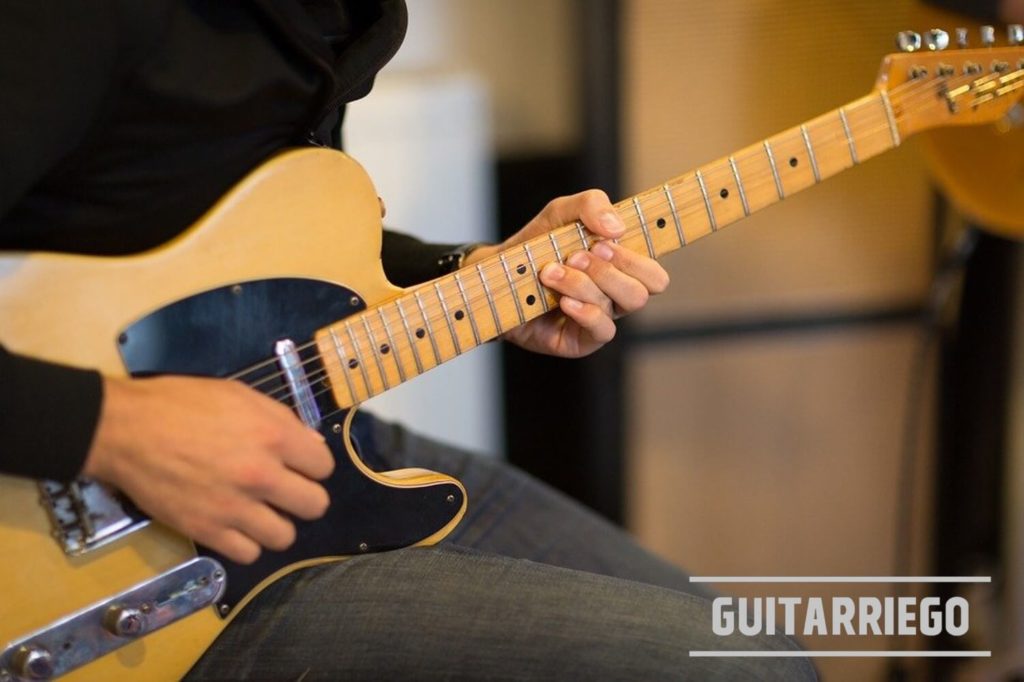Pentatonic scale for beginners – easy to learn to play guitar

The minor pentatonic guitar scale is popular and easy to learn, ideal for beginners, it is the quintessential scale for styles such as blues and rock, learn it easily and quickly.
Theory of the minor pentatonic scale for guitar
The minor pentatonic scale for electric or acoustic guitar is a very interesting scale. Besides being a very popular scale, used by styles like blues and classic rock, among others; It is a simplified scale, since instead of having seven notes, it has only five notes, hence its name Pentatonic. Thus, the minor pentatonic scale of A is: A, C, D, E, G.
This makes the pentatonic the easiest scale to play or execute for beginners just starting to play the guitar. But it is also a super scale used by experienced guitarists who play styles such as rock, blues, among others. Its scheme or structure on the fretboard or fretboard of the guitar is visually simple and very easy to remember or learn. Also, it is the fundamental basis of the blues scale that we will learn later.
Positions of the minor pentatonic scale on the guitar
As we saw in the guide to scales for beginners, there are different drawings that can be located in different places on the fretboard, and depending on where we support the note “1”, which is the tonic, we will be playing in the different keys.
Here we show the 5 positions of the A minor pentatonic scale, but if you move note 1 to a G, you will be playing the G scale, and so on with all the notes.
A minor pentatonic scale: Positions 1
The first position is the most used and is step one in learning the minor pentatonic scale. It has a simple and easy to remember drawing. You should use your 1 or index finger for notes on fret 5, finger 3 or ring for notes on fret 7 and finger 3 -annular- or 4 -pinky- for notes on treat 8. It is advisable to always use the little finger and use the ring finger on the 8th fret only when it requires greater force, for example to perform a stretch or bending.

A minor pentatonic scale: 2 positions
Position 2 is the second most used position and has the BB King Box.

BB King Box
The BB King Box is formed by “the box” that make up the notes on strings 1, 2 and 3 in position number 2. These 5 notes also form “the House of Blues” or “Blues House”, given its house shape. If, additionally, the second diminished is added -in violet color- the BB King Box is formed.

A minor pentatonic scale: 3 positions
Practice position 3 well before moving on to 4.

A minor pentatonic scale: 4 positions
Practice position 4 well before moving on to 5.

A minor pentatonic scale: 5 positions

A minor pentatonic scale: All positions

Knowing and understanding the pentatonic scale on the guitar
The first step is to memorize the different positions of the scales along the guitar fretboard, the structures, the notes, etc. Once you achieve it, the next step is to understand them, know them, feel what are passing notes, what are notes where you can rest, stressful notes, notes of rest and resolution.
You will learn to know which notes to use according to the chord on which you are playing. It does not sound the same when you play on a G, as when the base is playing a C or a Re. Later, we will see the functions of each of the notes in order to understand this more easily.
How to practice the pentatonic scale?
To practice and learn the pentatonic scale well, you must do exercises up and down. Do not forget to use the metronome, it is essential to play in tempo. Below we leave you some sheet music tablatures that will serve as a guide.
First, the ascending scale. We end it in the A of the first string, which is the tonic:
Then, the first position on the scale in ascending order:
Once you are well acquainted with the scale, an excellent exercise is to do the scale in ascending and descending triads. Also, triads are an excellent resource used by a lot of professional guitarists. Thus, you will not only be exercising, you will also add a super resource used by all kinds of guitarists.
Pentatonic exercise with ascending triads
Pentatonic exercise with descending triads
These exercises are all in position 1 of the minor pentatonic, but you can apply the same logic for all positions.
Once you have expanded it, you should seek to combine the different positions and achieve that they usually all as what they are, a single scale.
To practice the pentatonic!

The most used scale
The pentatonic scale is the first step into the world of blues and classic rock. Learn and become familiar with all their positions. They will allow you to understand what we play, and to be able to compose and write your own songs.
Once you learn the different positions of the scale well, you can continue to progress by learning the Blues Scale.
Remember, it is also important to transpose the scales to be able to use them in any shade and to know how to apply them to the length and width of the entire storage room.
Related Post: Blues Scale: Pentatonic Scale, Blue Note and Major Third.
You can share opinions or also chat about this and more with other musicians in our comments section.
For more information on the guitar, visit Guitar Quarter web site.






